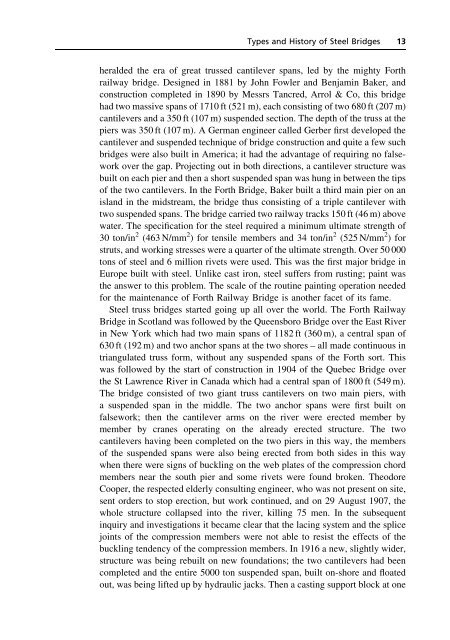The Design of Modern Steel Bridges - TEDI
The Design of Modern Steel Bridges - TEDI
The Design of Modern Steel Bridges - TEDI
Create successful ePaper yourself
Turn your PDF publications into a flip-book with our unique Google optimized e-Paper software.
Types and History <strong>of</strong> <strong>Steel</strong> <strong>Bridges</strong> 13<br />
heralded the era <strong>of</strong> great trussed cantilever spans, led by the mighty Forth<br />
railway bridge. <strong>Design</strong>ed in 1881 by John Fowler and Benjamin Baker, and<br />
construction completed in 1890 by Messrs Tancred, Arrol & Co, this bridge<br />
had two massive spans <strong>of</strong> 1710 ft (521 m), each consisting <strong>of</strong> two 680 ft (207 m)<br />
cantilevers and a 350 ft (107 m) suspended section. <strong>The</strong> depth <strong>of</strong> the truss at the<br />
piers was 350 ft (107 m). A German engineer called Gerber first developed the<br />
cantilever and suspended technique <strong>of</strong> bridge construction and quite a few such<br />
bridges were also built in America; it had the advantage <strong>of</strong> requiring no falsework<br />
over the gap. Projecting out in both directions, a cantilever structure was<br />
built on each pier and then a short suspended span was hung in between the tips<br />
<strong>of</strong> the two cantilevers. In the Forth Bridge, Baker built a third main pier on an<br />
island in the midstream, the bridge thus consisting <strong>of</strong> a triple cantilever with<br />
two suspended spans. <strong>The</strong> bridge carried two railway tracks 150 ft (46 m) above<br />
water. <strong>The</strong> specification for the steel required a minimum ultimate strength <strong>of</strong><br />
30 ton/in 2 (463 N/mm 2 ) for tensile members and 34 ton/in 2 (525 N/mm 2 ) for<br />
struts, and working stresses were a quarter <strong>of</strong> the ultimate strength. Over 50 000<br />
tons <strong>of</strong> steel and 6 million rivets were used. This was the first major bridge in<br />
Europe built with steel. Unlike cast iron, steel suffers from rusting; paint was<br />
the answer to this problem. <strong>The</strong> scale <strong>of</strong> the routine painting operation needed<br />
for the maintenance <strong>of</strong> Forth Railway Bridge is another facet <strong>of</strong> its fame.<br />
<strong>Steel</strong> truss bridges started going up all over the world. <strong>The</strong> Forth Railway<br />
Bridge in Scotland was followed by the Queensboro Bridge over the East River<br />
in New York which had two main spans <strong>of</strong> 1182 ft (360 m), a central span <strong>of</strong><br />
630 ft (192 m) and two anchor spans at the two shores – all made continuous in<br />
triangulated truss form, without any suspended spans <strong>of</strong> the Forth sort. This<br />
was followed by the start <strong>of</strong> construction in 1904 <strong>of</strong> the Quebec Bridge over<br />
the St Lawrence River in Canada which had a central span <strong>of</strong> 1800 ft (549 m).<br />
<strong>The</strong> bridge consisted <strong>of</strong> two giant truss cantilevers on two main piers, with<br />
a suspended span in the middle. <strong>The</strong> two anchor spans were first built on<br />
falsework; then the cantilever arms on the river were erected member by<br />
member by cranes operating on the already erected structure. <strong>The</strong> two<br />
cantilevers having been completed on the two piers in this way, the members<br />
<strong>of</strong> the suspended spans were also being erected from both sides in this way<br />
when there were signs <strong>of</strong> buckling on the web plates <strong>of</strong> the compression chord<br />
members near the south pier and some rivets were found broken. <strong>The</strong>odore<br />
Cooper, the respected elderly consulting engineer, who was not present on site,<br />
sent orders to stop erection, but work continued, and on 29 August 1907, the<br />
whole structure collapsed into the river, killing 75 men. In the subsequent<br />
inquiry and investigations it became clear that the lacing system and the splice<br />
joints <strong>of</strong> the compression members were not able to resist the effects <strong>of</strong> the<br />
buckling tendency <strong>of</strong> the compression members. In 1916 a new, slightly wider,<br />
structure was being rebuilt on new foundations; the two cantilevers had been<br />
completed and the entire 5000 ton suspended span, built on-shore and floated<br />
out, was being lifted up by hydraulic jacks. <strong>The</strong>n a casting support block at one


